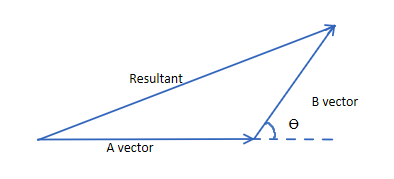11th And 12th > Physics
VECTORS MCQs
:
B, C, and D
For many purposes, two vectors ⃗A and ⃗B may be defined to be equal if they have the same magnitude and point in the same direction.
:
A
Multiplication of a vector by a real positive number n makes its magnitude n times but does not change the direction of the vector.
Hence the correct choice is (a).
:
B
The magnitude R of the resultant vector R of two vectors A and B inclined at an angle θ is given by
R2=A2+B2+2ABcosθ
cosθ=R2−A2−B22AB=(5)2−(3)2−(4)22×3×4=0
∴ θ=π2.
Hence the correct choice is (b)
:
D
If vectors A and B are equal, i.e. A = B, then their difference (A – B) is defined as a null vector. It has a zero magnitude and no specific direction.
Hence the correct choice is (d).
:
A
From the triangle law of vector addition, it is clear that the vectors R, A and B must be represented by the three sides of an equilateral triangle because the magnitudes of the three vectors are equal. Hence the angle α between vectors R and A is 60∘. Alternatively, the value of α is given by
tanα=BsinθA+Bcosθ=sinθ1+cosθ(∵A=B)
=sin120∘1+cos120∘=1.732
Which gives α=60∘.
Hence the correct choice is (a)
:
A and D
The magnitude R of the resultant of two vectors A and B depends upon the magnitudes of A and B and the angle θ between them and is given by
R2=A2+B2+2ABcosθ
When θ=0, R is maximum given by
R2max=A2+B2+2AB
or, Rmax=A+B
When θ=1800, R is minimum given by
R2max=A2+B2−2AB
or, Rmin=A−B
Thus, the magnitude of resultant will lie between A – B and A + B.
Hence the correct choices are (a) and (d).
:
B
From the diagram, both A and D have a magnitude of 2 units and are facing opposite directions.
:
C
:
D
You must swim somewhere between right and straight.
:
B
For 2 vectors to be equal their magnitude and direction has to be same.
Option A: says vector A and E surely they are pointed in the same direction but if we see magnitude wise the vector A has a magnitude of 2 units or it is only 2 boxes long, while vector E has magnitude of 3 units, so vector A & E can't be same.
Option B: says vector C & B, they are surely pointing in the same direction are their magnitudes also same.
Vector C has a unit of 2√2 units and so does vector B.
So option B is correct.
Here we conclude that we can translate a vector anywhere on the 3D space, it wouldn't change it as long as I keep the magnitude of the vector same and keep it pointing in the same direction.

















